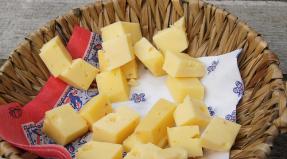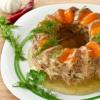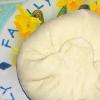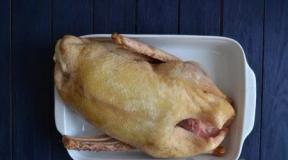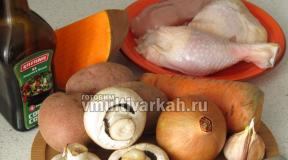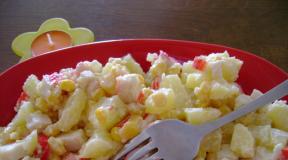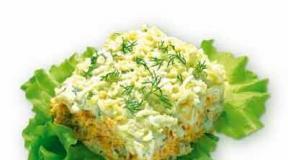Beijing cabbage in Korean. Chinese cabbage for the winter
Beijing type of cabbage has become popular relatively recently. The housewives appreciated the delicate taste, the great benefits of this vegetable and learned how to cook interesting dishes from it. Despite the fact that Chinese cabbage can be bought in winter, many tend to prepare it in the warm season.
Beijing cabbage: the easiest way to harvest
This herbaceous vegetable is considered richer in useful trace elements and vitamins than white cabbage, traditional for domestic gardeners. If you do not have the time and desire to do pickles, you can simply try to freeze Peking leaves. So you get a ready-made semi-finished product, from which side dishes, salads or soups come out - everything is the same as from fresh Chinese cabbage. Freezing process:
- divide the head of cabbage into leaves;
- dip them in boiling water for 1 minute, then immediately - in cold water;
- put on a dry paper or kitchen towel;

- wait until the water drains and the leaves dry;
- fold them into a hermetically sealed (tied) bag or sudok;
- place in the freezer.
Attention! For any type of preparation, only whole, healthy and fully ripened heads are suitable.
Vitamin Chinese cabbage salad
This recipe is considered a classic. Marinated cabbage salad is great as an addition to lunch dishes or can be an appetizer on its own. For cooking you will need:
- 1 kg of cabbage;
- 0.5 kg of onions;
- 0.5 kg of bell pepper (not necessarily large, having a presentable appearance);
- a pod of hot pepper;
- water - 1 l;
- apple cider vinegar - 100 g;
- sugar - 100 g, salt - half as much.
Recipe:

Attention! The indicated amount of ingredients is enough for two liter jars.
Another type of Beijing cabbage pickling is without blockage under the lid. The ingredients are almost the same, plus one head of garlic, but minus the onion. Yes, and the calculation is made for one head of cabbage. Recipe:
- prepare the marinade: mix both varieties of peppers in crushed form with salt, sugar, freshly boiled water (250 ml), vinegar and finely chopped garlic;
- cut the head of cabbage into 4 parts and place in a voluminous enameled container;
- drain the marinade, pushing the leaves of cabbage quarters with a fork;
- cover the cut with a piece of clean gauze;
- place a plate on top, approximately equal in diameter to the pan;
- press it all down with a load.
The container should stand in the room for 2 days. After that, the content will decrease in volume. At this point, you need to shift the cut into a clean jar and refrigerate. In this form, tender to taste, the workpiece is stored for about 2 weeks.
Kimchi: a recipe from Korea
This traditional Korean dish is easy to prepare. In fact, this is a kind of pickled vegetable, only with a spicy spicy sauce. You will need:

- 1 kg of cabbage;
- water - 1 l;
- salt - 3.5 tbsp. l.;
- garlic - 8 large cloves;
- chili pepper - 1 pod.
Cooking method:
- Divide the head of cabbage into quarters. Place in a saucepan and pour salted boiling water (3 tablespoons per 1 liter). Cover with a lid and leave the container in the room for a day.
- Pepper and garlic should be crushed into a pulp. Mix both ingredients and add 0.5 tbsp. l. salt. Dilute the mixture with a little water.
- Both gruel and cabbage should be removed separately in the refrigerator and kept there for another day.
- Drain the brine into another container (you will still need it). Coat each cabbage leaf with spicy gruel.
- Put the cabbage in a container for brining. Fill with brine again, cover with gauze, a clean lid and press down with oppression. Store for two days at room temperature.
- The cabbage is ready. Transfer it to a more convenient dish, add a little brine and refrigerate.
Salted chinese cabbage
Like the white variety, this cabbage is an excellent salty snack with an appetizing flavor. It goes well with meat, fish, especially on a vitamin-poor winter table. Cabbage pickle is easy to prepare:

- Chop the sheets into pieces of the size you need. For example, for salting in a barrel or pan, cut coarsely, and for a 3-liter jar, it is better to chop into thin strips.
- Pack tightly into a suitable container. Sprinkle with salt. For 1 kg of green mass, there are 100 g.
- Place seasonings to taste in a container: allspice, bay leaf or cloves.
- Tamp the contents again. Cover with gauze. Press down with a load.
Advice. Under room conditions, cabbage will cook for about 1 month. You can periodically taste the leaves, choosing the right degree of salting for yourself.
An important characteristic of this Asian-born vegetable is the long shelf life of all valuable properties. However, cabbage, bought or grown in the fall, still does not live up to the New Year, no matter how hard you try. In this case, it is appropriate to preserve it as part of delicious dishes. Snacks are easy to prepare and retain the nutrients needed for a winter vitamin deficiency.
How to salt Chinese cabbage: video
Beijing cabbage has many useful properties, which makes it similar to white cabbage. At the same time, few people know how to salt Chinese cabbage for the winter. The taste of such a vegetable is soft, more delicate and pleasant. Due to the absence of tart juice, the preparation is suitable for absolutely everyone. The article presents the best step-by-step recipes, among which everyone will find something for themselves.
First you need to purchase the amount of vegetables that is indicated in a particular recipe. It is important to pay attention to the leaves, which should be neither white nor bright green. Spoiled or rotten leaves of Chinese cabbage are removed, the rest are coarsely or finely chopped, depending on the specifics of the recipe. Sometimes they are torn off the head and processed separately.
Video "How to salt Chinese cabbage for the winter"
From this video you will learn the recipe for salting Chinese cabbage for the winter.
Step by step recipes
The article presents recipes that combine spicy spices, add various components. The result is a delicious preparation that can be used both independently and with a side dish.
in Korean
To pickle a Korean-style vegetable, you will need the following ingredients: 1.5 kg of Chinese cabbage, 20 g of garlic cloves, 5 g of ground red pepper, 2 tsp each. salt and sugar.
Cooking process:
- Wash and drain cabbage.
- Remove top leaves.
- Divide the head of cabbage into quarters.
- Grind the garlic, mix with pepper, salt and sugar.
- Grate the cabbage leaves with the resulting mass.
- Place in a container, put under pressure.
- For salting, leave for 10 hours.
- After the specified time, cut into pieces.
Salting from Beijing cabbage in Korean is ready for use.
With pears
Pickled Chinese cabbage goes well with other vegetables. Less often it is combined with fruits, but it is quite real, healthy and appetizing. Of course, it is worth salting it with a pear. For this recipe, it is best to use green and unripe fruits, so their flesh does not fall apart during salting. An appetizer that will delight you with summer taste and winter aroma.
The following ingredients are needed: 1 head of Chinese cabbage, 2 small pears, 3 cloves of garlic, 5 green onion feathers, 3 cm of ginger root, 2 pinches of ground red pepper, 4 tbsp. l. salt, 200 ml of pure water.
To pickle a vegetable with a pear, the hostess needs:
- Rinse all vegetables, chop cabbage.
- Remove the skin from the pears, cut so that the seeds are removed.
- Then cut into small slices.
- Place vegetables and fruits in a jar, sprinkle with salt, mix with your hands.
- Pour in water, cover and leave overnight in the refrigerator.
- Drain the resulting juice into a special container.
- Add grated ginger, garlic gruel and pepper to the mass.
- Add chopped green onions and stir.
- Pour juice, leave warm for three days.
- After fermentation roll up and clean in a cool room.
with pepper
Being salted, Beijing cabbage gets new taste qualities. With the help of pepper, it will become spicy and spicy. For such a snack, 1.5 kg of cabbage, 500 g of salt, 3 pods of hot pepper, 150 g of sweet pepper, 1 tbsp. l. coriander and ginger, 2 g ground pepper, 8-9 garlic cloves.
Salting is prepared as follows:
- Separate the cabbage into individual leaves.
- Grate each leaf with salt, place in a container for 10 hours, preferably at night.
- After the specified time, rinse the leaves, remove excess salt.
- Peel and grate the ginger root, hot pepper and garlic.
- Salad pepper clean and finely chop.
- Throw spices into the vegetable mass, mix.
- If the mixture is dry, you can add a little water.
- Coat each leaf with a sharp mass on both sides.
- Put the cabbage leaves in glass jars in which they will be stored for a long time.
- Initially, leave it warm so that seasonings and spices give off aromas and tastes.
- Then put the jars in the refrigerator.
in banks
To prepare a quick preparation, you will need an average head of cabbage, 5 tbsp. l. sugar, 1 tbsp. l. salt, 100 ml of vinegar and chili pepper.
Cooking steps:
- Cut the cabbage into strips, pepper - into cubes.
- In a bowl, mix pepper and cabbage, salt.
- Put in the refrigerator, at this time make a brine.
- Mix sugar and vinegar, boil.
- Pour into cabbage, mix, place in a jar.
- Pour the juice remaining from the cabbage into the same jar.
- Cover with a lid, dip in boiling water for 15 minutes.
- Wrap tightly and place under a blanket.
Beijing cabbage is good both fresh and salted. In the process of salting, it is recommended to use different spices, vegetables and herbs. Salting will appeal to all home and guests, and will also remind you of summer in the winter cold.
Spicy and spicy Peking cabbage is good as an independent snack on the festive table. It is also often used as an addition to potatoes, rice, cereals. Even novice housewives can pickle a vegetable.
Foreword
Peking cabbage is no less useful than white cabbage, and is not inferior to it in terms of vitamin C content, and even surpasses it in the amount of some other trace elements. Its main advantage is that this "wealth" is kept fresh in it throughout the entire shelf life. Unfortunately, it is not large, and in order to satisfy the body's needs for Beijing cabbage all year round, various preparations for the winter are additionally made from it.
Fresh Chinese cabbage storage in winter
The longer a vegetable is stored fresh, the less vitamins remain in it, and its benefits to the body decrease. Quite another thing is Chinese cabbage. This is perhaps the only vegetable that retains all the vitamins and minerals throughout the entire storage period. In addition, Beijing is best eaten fresh - in salads. With any processing in the process of harvesting it for the winter, the amount of vitamins in it decreases.
Therefore, in the case of cooking any dishes associated with thermal or other processing of Beijing (borscht, pies, cabbage rolls or stewed, pickled, salted cabbage), it is again better to take it fresh. For long-term storage in winter, it is necessary to collect no earlier than the end of September. At the same time, in order for it to lie longer, the following nuances should be taken into account:
- The heads of cabbage must be dry - harvesting should be done only after the morning dew has left the soil and / or the raindrops have completely evaporated, if any.
- It is better not to delay harvesting - this must be done before the onset of the first frost. If Pekinka experiences a temperature drop of even -2 ° C, then it will begin to rot soon after laying in storage.
- Heads of cabbage should be cut just under the leaves, being careful not to damage their central veins.
- Only firm young heads of cabbage that do not have any damage, without mucus and brown dots, that is, absolutely healthy, should be stored for storage.
- Upper leaves with minor defects should be removed. Strongly "undress" the cabbage is not worth it. If you can’t do without it, then it’s better to refuse to store it fresh, because the smaller the top leaves, the more Peking is subject to drying out.
In special storage facilities for Beijing cabbage, certain conditions are created. They monitor not only the temperature regime and humidity, but even control the content of carbon dioxide (CO 2) and oxygen (O 2) in the atmosphere of the premises where the Beijing lies, and also take other measures. And they do it all taking into account a particular variety of cabbage. Under such conditions, the shelf life of Pekinka can reach as much as five months.
In the cellar or basement, it is hardly possible to create the same “resort” for Beijing cabbage. But, by fulfilling the basic requirements for its storage, you can ensure that it will lie for 1-2 months, and if you're lucky, then all 3. These are the conditions:
- The air humidity in the storage is 95–98%. With a smaller fork, they will wither, and with a larger one, there is a risk of fungal infection and rotting.
- Temperature +2–+3 °C.
- Fresh apples and other fruits should not be stored indoors. They emit ethylene, to which Pekinese is very sensitive.

If the above shelf life of fresh Beijing cabbage expires, then it should be used for cooking. Otherwise, it will still deteriorate, and it can rot from the inside, which will not be noticeable on the upper leaves. Before laying for the winter, it is not necessary to wash it. After assembly, it should be cooled as soon as possible to storage temperature, and only then immediately laid out horizontally in boxes, the bottom of which is recommended to be covered with perforated foil to reduce moisture loss from the forks.
When it is not possible to keep Beijing cabbage fresh, and also in order not to deprive yourself of the pleasure of eating it until the next harvest, various preparations are made from it for the winter. Most often, Beijing is pickled or salted.
General rules for harvesting
Regardless of the recipe, cabbage forks should be young, mature, undamaged, frost-bitten, wilted, and healthy. At the head of cabbage, before using it, we remove, if possible, only the upper leaves, and, if necessary, the following ones if they are damaged or spoiled. Local defective places can simply be cut out with a knife.

All products used for harvesting are also washed and cleaned. Remove the stem and seeds from the peppers. It is necessary to lay out the workpiece only in clean, sterilized jars. To clog the latter, we use lids that have undergone a similar pre-treatment, polyethylene can be used if cabbage is supposed to be stored for no more than 2–3 months.
It is necessary to store Beijing blanks for the winter in a dark, cool room or place - a cellar or a refrigerator. If the finished product is hot immediately after corking (boiling brine was poured, cabbage was sterilized), then first it must be allowed to cool to room temperature. Moreover, if the lids on the containers are metal, twisted or rolled up, then the jars are turned upside down, placed on a thick cloth and covered with a warm thing. Only after cooling, the blanks are removed for storage.
Pickled cabbage - in the best traditions of Chinese cuisine
Beijing cabbage is a guest from China. And most of the recipes for its preparation, which came with it from the same place, from the so-called spicy cuisine of this country - Sichuan. That is, dishes from this vegetable must contain garlic and / or red pepper, which makes them spicy. This also applies to recipes for harvesting marinated Beijing for the winter.
Cabbage with sweet peppers and onions. You will need:
- cabbage - 1 kg;
- sweet pepper and onion - 0.5 kg each;
- hot pepper (pods) - 1 pc;
- apple cider vinegar - 100 g;
- non-iodized salt - 50 g;
- sugar - 100 g;
- water - 1 l.

We disassemble the Beijing into leaves, which we cut into large pieces. Then we chop the pepper: sweet - in thin strips, slices, and hot - in small cubes. Onion cut into rings. Mix all the vegetables thoroughly in a large bowl, and then transfer them to jars, where we pack them well. Pour vinegar into the water, add salt and sugar. We heat the resulting mixture to a boil, cook for 15 minutes. Then pour the vegetables with boiling marinade and close the lids.
Japanese marinated. You will need:
- cabbage (heads) - 1 pc;
- garlic (cloves) - 2-3 pcs;
- sugar - 3 tbsp. spoons;
- red hot pepper (ground) - 0.5 tsp;
- non-iodized salt - 3 teaspoons;
- Japanese light rice vinegar - 1/3 cup;
- water - 1.5 l.
Peking head of cabbage first cut in half. Then we chop each half into strips about 2–3 cm wide. Pass the garlic through a press. We spread the cabbage in a jar, and add garlic and pepper to it on top. We are preparing the marinade. Here it is necessary to follow a certain order - the Japanese have their own approach to pickled Chinese cabbage, as well as to the preparation of other dishes. Sugar is first added to the water, then salt, and then vinegar. As Japanese chefs rightly believe, such a sequence of adding spices contributes to a more complete disclosure of the taste of the product, dish.

So, pour sugar into boiled water, and then salt. We carefully dissolve and stir everything, then taste the marinade. The solution should be slightly salty. If necessary, adjust the taste by adding salt or sugar. Then pour in the vinegar. Mix again and pour cabbage with boiling marinade. Cover the container with a lid and leave to cool to room temperature. When the marinade in the container has cooled down, and the Beijing has settled, tightly close it with a lid and hide it for storage.
Pickling Beijing - recipes from the homeland of the vegetable
By and large, there are almost no differences between the salting of Beijing and the like. After all, although they are distant, they are still relatives. And in principle, any recipe for salting white cabbage can be used when harvesting Beijing cabbage. The result will not be worse. The main thing is to choose the “right” heads of Beijing. It is very important to purchase forks that are not too white or green.
In the first case, the cabbage will quickly deteriorate, and in the second, it will most likely be salted in parts. It is recommended to take something in between. The size of the head doesn't matter. It is best to do the pickling of Pekinka according to the recipes of the country from where it was brought to us. The most popular are spicy cabbage, the so-called kimchi. By the way, the very first recipes for such preparation of Beijing belong to Korea. Today, kimchi is made in a variety of ways. Below are 2 recipes.

The easiest option. You will need:
- Beijing - 3 kg;
- red hot pepper (pods) - to taste;
- garlic (heads) - 3 pcs;
- salt and spices - to taste.
Large heads of cabbage should be cut into 4 parts, small ones - into 2, and small ones - left whole. We wash their leaves, and then immediately rub the last with salt. Without tamping, we put the cabbage in a container and leave it in a cool place for about a day. The next day, we pass the garlic through a meat grinder, on which a large mesh must be installed. Chop the pepper with a knife and mix with garlic. We take out the cabbage and wash it from salt. Wearing gloves on your hands, rub each leaf with a sharp mixture.
Then we put the Beijing back into the container and leave it in some warm place for about a day. Then we lay it out very tightly in jars, cork it and hide it for storage.
Pear recipe. The original Korean recipe should have yam tubers - sweet potatoes. Instead, you can take pears, preferably unripe and hard. For kimchi you will need:
- Pekinka (heads of cabbage) - 1 pc;
- pears - 2 pcs;
- garlic (cloves) - 3 pcs;
- green onions (feathers) - 5 pcs;
- ginger root (peeled) - 2.5–3 cm;
- red hot pepper (ground chili) - to taste;
- non-iodized salt - 4 tbsp. spoons;
- water - 200 ml.

We chop the Beijing, free the pears from the skin, and then cut into thin slices. We put them in a jar, preferably with a wide neck. Add salt to them. Then mix everything thoroughly with your hands and crush. Then we fill the products with water. We cover the container with a lid and send it to the refrigerator overnight.
The next day, the brine obtained in the jar is poured into a cup. Without removing the pears with cabbage from the container, add finely chopped garlic, pepper, ginger and onion to them. We mix everything, and then fill it with “native” brine. Covering the container with cling film, put it in a warm place. After 3 days, cork with a lid and hide for storage.
Beijing cabbage has a more delicate texture than white cabbage. Therefore, pickling Beijing cabbage for the winter is fast, as well as, the main thing is to choose a good marinade that will taste right for you. For snacks, you need to select more savory mixtures, and for salads, you can take the mixture more gently.

Such a preparation involves pickling cabbage in large pieces, but in some cases it is inconvenient to use it. Then you can just cut it into strips or cubes before use. Then it can be used in any dishes, regardless of how it was originally prepared.
Required Ingredients:
- Beijing cabbage - 1 kilogram;
- Bitter pepper - 1 pod;
- Sweet pepper - 0.5 kilograms;
- Onion - 0.5 kilograms;
- Apple cider vinegar - 100 grams;
- Sugar - 100 gr.;
- Salt - 50 grams;
- Water - 1 l.
Recipe for cabbage pickled Beijing winter:
- Before cooking, you need to prepare the marinade. In the pan you need to measure the required amount of liquid, add sugar, salt, vinegar. The mixture is put on fire and simmered over low heat for 15 minutes. The mass should not boil all this time, otherwise the vinegar will completely evaporate and only a solution with salt and sugar will remain;
- While the solution is languishing, you can proceed to the processing of vegetables. The cabbage is cut into large pieces, the head of cabbage can be cut into 4 pieces or a little smaller. Hot pepper is washed, cleaned of seeds, cut into small cubes. Peel the onion, carefully cut into thin rings. Rinse sweet pepper, remove seeds, chop into thin slices; 3. Rinse, sterilize and dry containers for blanks. The simplest is to use glass jars;
- Transfer all previously prepared vegetables to a large container and mix. It is better to do this with your hands so that the mass does not wrinkle, but it is mixed. Now the mass can be laid out in banks and carefully tamped;
- Now you can fill the container with a hot marinade solution and immediately roll up the lids;
- Tara is stored under a warm blanket until they are completely cool. Then they are removed to a permanent storage place.
Pickled Chinese cabbage for the winter

Only thick parts of the leaf can be used in this recipe, which are usually not used in fresh salads, as they are too tough. But for pickling, such pulp is best suited, it will not become soft during the pickling process, but will remain juicy and crispy. Thanks to this recipe, the entire mass of the head of cabbage is used for food.
Required Ingredients:
- Beijing - 1 kilogram;
- Sugar - 5 tbsp. l.;
- Salt - 1 tbsp. l.;
- Hot chili pepper - 1 pod;
- Table vinegar 9% - 80-100 ml.
Beijing cabbage pickling recipes:
- Before you start cooking, the head of cabbage must be prepared in a special way. It must be divided into white bases and green leaves. We need exactly the fleshy white bases, cut them into strips and transfer them to a separate container;
- Then you need to rinse the pepper, remove the seeds and cut into small cubes;
- Pepper is mixed with the mass, add the required amount of salt and mix well, you can mix with your hands. Put the mixture in the refrigerator for 1 hour to extract the juice;
- While the cabbage mass is infused, it is necessary to prepare the marinade and containers for blanks. The container must be washed, put over steam for sterilization, then put upside down on a towel to cool slightly;
- The marinade is made from vinegar to which sugar is added. The mixture should boil. Pour vegetables with a boiling mixture, wait a bit and you can transfer the mixture to prepared jars, you need to tamp the mixture a little. The blank must be filled to the top with the prepared marinade;
- Cover the containers with lids and put in boiling water. They should boil for 15 minutes. But if the jars are large, then you can increase the sterilization time to 30 minutes;
- It remains only to pull the container out of boiling water, turn it over, put it under a warm blanket and leave it for 1-2 days.
Spicy Pickled Chinese Cabbage

If the hostess did not have a pod of hot pepper to prepare a spicy recipe, then it is quite possible to use ground black pepper. Of course, the taste will be a little different, but the preparation will still be spicy and tasty. Those who do not like spicy food at all can not use pepper in the recipe, the marinade in this case will be tender and slightly sour.
Required Ingredients:
- Beijing cabbage - 1 kilogram;
- Onions - 300 grams;
- Bulgarian pepper - 300 grams;
- Hot pepper - 1 pod;
- Sugar - 100 grams;
- Salt - 50 grams;
- Vinegar - 1 teaspoon;
- Pure water - liter.
How to pickle Chinese cabbage for the winter:
- Vegetables are prepared as follows: wash the cabbage, cut into long thin strips, peel and cut the onion into rings, wash the pepper, remove the seeds and cut into thin strips;
- Prepared vegetables can be immediately put into prepared jars, tamped tightly, so they will be better pickled and stored;
- Now you should prepare the marinade. To prepare it, boil water, pour salt, sugar and vinegar solution into it, boil a little and remove from the stove;
- Immediately pour the pulp with a boiling solution, put a pod of hot pepper and immediately roll up with iron lids;
- The blanks can be put under a blanket so that they are well steamed and cool for a long time, and then removed in the cold.
Pickled Chinese cabbage with beets

When harvesting cabbage, it does not have a beautiful color, it turns out to be pale and inconspicuous. And with the addition of carrots and beets, the workpiece acquires an interesting color combination, and the pale cabbage is tinted a little. The marinade also contains enough ingredients that combine to create an unusual spin flavor.
Required Ingredients:
- Beijing - 2 kilograms;
- Garlic - 1 piece;
- Fresh carrots - 2 pieces;
- Beets - 1 small fruit;
- Vegetable oil - 200 milliliters;
- Sugar - 200 grams;
- Bay leaf - 2 leaves;
- Salt - 2 tbsp. spoons;
- Black pepper - 2 peas;
- Hot pepper - 1/2 pod;
- Table vinegar - 150 milliliters;
- Water - 1000 milliliters.
Step by step cooking instructions:
- Root crops are washed, chopped into large squares, their size should be approximately 3X3 centimeters;
- Wash the beets, peel, cut into thin strips;
- Peel the carrots from the rough peel, cut into thin strips;
- Combine all prepared vegetables in a separate bowl and mix thoroughly;
- Now you need to leave the vegetables and proceed to the preparation of the marinade. First, clean water is boiled, the necessary spices are added, as well as hot peppers. When the mixture boils, you can remove it from the heat and add measured vinegar, mix everything well and pour into the prepared vegetables;
- Such a blank should be in the room for about a day, but on top the mass must be covered with a plate so that the pulp does not float up and excess debris does not get into it;
- After that, the mixture can be transferred to separate containers and put in the cold;
- The container can be sterilized, then the twists can be stored in a normal room.
Pickled Chinese cabbage in Korean for the winter

Everyone knows carrots in Korean, but few housewives harvested cabbage in Korean. It turns out the same crispy, appetizing and spicy. The spiciness can be adjusted by the amount of hot pepper and garlic. Dressing for cabbage should be quite spicy, but you can put a little less spiciness. The head of cabbage does not need to be finely chopped, which significantly reduces the preparation time for this recipe for harvesting for the winter.
Required Ingredients:
- Beijing - 1.5 kg .;
- Garlic - 6 cloves;
- Ground pepper - 4 tablespoons;
- Sugar - a teaspoon;
- Salt - 150 grams;
- Fresh water - 2 liters.
Pickled Beijing cabbage instant:
- The head of cabbage should be washed, removed from it the extra upper leaves and cut into pieces. You can not disassemble the head of cabbage into separate pieces, but simply cut it into 4 parts. The pulp is cut into the necessary pieces just before use;
- Transfer the pulp to a separate bowl and leave;
- Now it is worth mixing boiling water with salt, stirring until the crystals are completely dissolved, cool;
- Pour the prepared pulp with the cooled solution, the solution must completely cover the mass;
- The mixture is left in the room for 12 hours, only it needs to be covered, for this you can use a small plate, it will hold the pulp under the solution. During the pickling process, it is necessary to mix the pulp several times so that it is completely saturated with the solution;
- Separately, combine finely chopped garlic, sugar and hot pepper, mix the mass, add a couple of tablespoons of water and rub the resulting mass well;
- Grate the leaves obtained with the solution, it is important to ensure that each leaf is completely covered with the mass. If a head of cabbage is pickled, cut into pieces, then you need to carefully bend the leaves and coat them inside. Transfer the mass to separate jars, pour the container with brine to the very top. Now you can close the containers with lids and send the blanks to a cool place;
- Such a blank can be stored in a large enameled pan. And it will be ready in a couple of days. Blanks without sterilization can only be stored in a cool and dark place.
Based on the composition of the marinade, cabbage can turn out to be more spicy or, on the contrary, quite tender. But for pickling, you should choose only dense pulp, which, when exposed to the marinade, will not become too soft and tasteless. Properly cooked Pekinka is always crunchy appetizing.
Kimchi (or kimchi) is a traditional Korean dish, which means any pickled (fermented) vegetables: radish, cucumbers, lettuce, onions. But the most popular recipes are Chinese cabbage in Korean. Koreans believe that kimchi is a source of longevity and health, and the American Health magazine included it in the top five healthiest foods in the world. In Korea, not a single meal can do without it, and in Seoul there is even a kimchi museum, where 187 different varieties of this food are presented!
Thanks to scientifically proven beneficial properties and unique piquant taste, the dish has become popular in many countries of the world. In different sources, you can find other names for it: kimchi, kim-chi, chim-cha, chimchha, chimchi, chamcha.
The secret of the dish is in the fermentation process, which not only preserves all the useful substances, but also significantly enhances their valuable properties. The list of positive effects that kimchi has on the body is quite impressive:
It is not surprising that in Korea, kimchi is not just a traditional dish, but also an integral part of the culture, the national symbol of the country. Museums are built in honor of him, festivals are organized. At the Seoul Kimchi Museum, you can learn about how kimchi gained worldwide recognition, see the work of Korean artist Kim Yong-hun dedicated to this dish, see in detail the process of its preparation, as well as a visual demonstration of how kimchi affects the digestive process.
At the museum, the Kimchi University for adults and the Kimchi School for children are open, master classes and educational programs for tourists are held - thanks to this, everyone can master the art of preparing this product.
Despite such great benefits for the body, jimchi should be consumed in very moderate amounts, since the dish contains spicy ingredients and salt!
 In Korea, there is no single variation on how to make jimchi—recipes vary greatly depending on the region, climate, and season. Yes, and each family has its own pickling secrets, which are passed down from generation to generation. In Russia, kimchi recipes have undergone some changes, as not all ingredients for the Korean dish are available in stores. However, this did not make kimchi less useful and tasty.
In Korea, there is no single variation on how to make jimchi—recipes vary greatly depending on the region, climate, and season. Yes, and each family has its own pickling secrets, which are passed down from generation to generation. In Russia, kimchi recipes have undergone some changes, as not all ingredients for the Korean dish are available in stores. However, this did not make kimchi less useful and tasty.
You can serve a savory snack with any side dishes, meat and fish, noodles - kimchi goes well with many dishes. When serving the table, it is recommended to place a small transparent bowl with pickled cabbage next to the dinner plate.
Classic cooking method
The first step in making kimchi is salting cabbage heads. To prepare spicy Beijing cabbage in Korean, you will need:

Cabbage forks should be cut in half and placed in a food container, large pot or barrel.
Now we are preparing brine, which is salt diluted in water. Additionally, we take a little salt and sprinkle the cabbage leaves (but do not rub the salt!). We fill the cabbage with brine and put oppression on top so that the heads of cabbage are better salted. We leave for 1-2 days. After that, we take out the vegetable, gently rinse it under running water to wash off the salt between the leaves, squeeze it well - twist it. If excess water is not removed, then the marinating paste will not absorb well into the leaves.
Now it's time for refueling. All ingredients for it must be ground in a blender. The exception is the carrot - it can be chopped or grated. Green onions can be coarsely chopped with a knife.
Now you need to cook rice jelly. You can do without it, but many Koreans believe that without it they cannot achieve the desired consistency of dressing. You can try both kimchi pickling options and choose the one you like best.
For 0.5 cups of rice flour, you need about three cups of water. Cook the jelly for about half an hour until it becomes viscous. To avoid lumps, it is recommended to pour water gradually, stirring thoroughly with a whisk. After cooking, the jelly must be cooled.
Mix fish sauce, ground spices, vegetables and jelly. With the resulting mixture, you need to thoroughly coat the halves of the cabbage heads between the sheets. It is best to do this with gloves, because the paste not only burns the hands, but can also stain the skin and nails. Each sheet is generously smeared on both sides. Don't be stingy with dressings, put more at the base of the forks - where the leaves are thickest.
After smearing the cabbage, put it in tightly closed containers (at the same time, carefully compress the heads of cabbage so that the cabbage gives more juice) and put it in the refrigerator or cellar for a day - this is the final step in the step-by-step recipe for Chinese cabbage in Korean. The finished snack should be cut into pieces, optionally seasoned with vegetable oil or mayonnaise. You can serve at the table!
Chinese cabbage with bell pepper
An appetizer prepared with bell peppers has a sweetish taste and appetizing fresh aroma. For cooking, you will need the following components:
- Beijing - 3 kg;
- water and salt for brine;
- bell pepper - 1 piece;
- garlic - 10-12 cloves;
- one carrot;
- one pear;
- bulb;
- green onions - a bunch;
- sugar - 1 tablespoon;
- 2-3 tablespoons red pepper flakes (you can grind the chili pods);
- 1-2 cups of rice flour jelly (the cooking method is described in the previous recipe).
Cabbage, as in the classic version, is cut into halves, poured with brine and insisted for a couple of days under oppression, after which it is washed and squeezed well.
Kissel, sugar and red pepper are combined separately. Grind vegetables, garlic and pear with a blender. Carrots and green peppers can be finely chopped - for beauty. All components are thoroughly mixed and the resulting paste is generously smeared with Peking leaves on both sides.
The appetizer is tightly packed in containers or jars, covered with lids and sent to the refrigerator for a day or two (the longer the appetizer is kept, the more piquant and rich the taste will be as a result. If you have enough patience, let the cabbage brew for 2 weeks - this is considered the ideal time for fermentation ). Before serving, the cabbage is cut into pieces and poured with vegetable oil.
Spicy chimchi soup
Korean-style spicy Beijing cabbage can be used not only as a cold appetizer. From it you can cook a very tasty soup - kimchichjigae. It has a pleasant spiciness and a rather thick texture, like a stew or shurpa. An important condition - kimchi for soup must be aged for at least a week - too young will not give the desired taste and aroma. For cooking you will need:
- Beijing chimchi - 2 cups;
- pork loin - 150 g;
- 2-3 cloves of garlic;
- chopped chili - 1 teaspoon (you can do without it if the kimchi is quite spicy);
- juice from kimchi - 0.5 cups;
- ground ginger root - 0.5 teaspoon;
- 2 glasses of water;
- tofu cheese - 200 g;
- a few feathers of green onions;
- salt and black pepper - to taste.
Cut the loin and kimchi into small pieces, chop the garlic. Simmer in a pan with chili and ginger over medium heat for about 10 minutes. Pour in the kimchi brine and water and simmer for about 20 minutes. The amount of water can be adjusted depending on how thick the soup you want to get.
Cut the tofu and green onion into slices, dip into the soup, add black pepper. Salt is added as desired, since the cabbage and brine are salty. Cook for a few more minutes and remove from the stove. The soup is served hot. Pork can be successfully replaced with canned fish, such as tuna or saury.
Roast with pork chimchizhar
An incredibly tasty and juicy hot dish can be prepared from pork and Beijing in Korean style. Try it - it will certainly become one of your favorite foods! The list of ingredients is very simple:
- Beijing cabbage - 0.5 kg;
- onion - 0.4 kg;
- pork - 0.5 kg;
- a couple of cloves of garlic
- salt, black ground pepper - to taste;
- vegetable oil for frying.
Kimchi must be well aged - at least a week, so that the taste of the dish is brighter and richer. You do not need to squeeze the chimchi - the sauce will be needed to prepare the roast.
We cut the pork into cubes, fry in a pan with butter - do not cover with a lid. Coarsely chop the onion, put it on top of the pork. Cook for a couple of minutes, then stir. When the onion begins to brown, put the kimchi into the pan, cut into small pieces. Squeeze the garlic into the roast, add the chimchi brine, salt (do not overdo it!) And pepper to taste. Cover the pan with a lid and cook for about 10 more minutes. Chimchijar can be served with a side dish of rice and chopped herbs.
There is a whole sea of Chinese cabbage chamcha recipes: with seafood, green beans, Chinese radish (daikon), fish and other ingredients. Some culinary specialists put red fish between the leaves of Pekinka during pickling - salmon or chum salmon salted in this way turns out to be unusually tasty. Do not be afraid to experiment - it is almost impossible to spoil the taste of kimchi!


